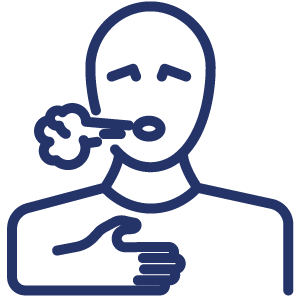Publication date: March 18, 2020
THE ORGANISMS WE CANNOT SEE BUT WHICH WE FEAR…
THE STORY OF TWO VIRUSES AND ONE BACTERIUM
Coronavirus is a hot topic because it represents the threat of the unknown. But what about those other pathogens we tend to watch as they spread and, since they’re old news, we pay them no mind?
Here we will compare these 3 microscopic entities (both the new and the old):
WHO IS WHO?
|
|
||
|---|---|---|
| CORONAVIRUS 2019-nCoV February 2020 data |
INFLUENZA February 2020 data |
MYCOPLASMA February 2020 data |
| **New** 2019 China History: Other coronaviruses that made the news SARS-CoV (Severe Acute Respiratory Syndrome coronavirus) year: 2020 MERS-CoV (Middle East Respiratory Syndrome coronavirus) year 2012 64,473 cases worldwide 1,384 deaths (worldometers.info) It is easily contagious and remains alive on surfaces for up to nine days. Not reported in PR There is NO vaccine Treatment research underway | Known for approximately 2,400 years
History: It has caused historic pandemics Causes yearly flares worldwide (peak season runs from August to March) 22 to 31 million cases in the US in 2019. 12,000 to 30,000 deaths in the US in 2019 In PR, thousands of cases have been reported, and deaths have occurred There is a vaccine Treated with antivirals |
Reported in 1930; named in 1944
History: It is common worldwide and may lead to infections throughout the year (peak season runs from summer to early fall) 2 million cases every year in the United States Flares are currently reported in PR There is NO vaccine Treated with antibiotics |
|
|
||
| Fever Coughing Difficulty breathing Runny nose |
Sore throat Fatigue Fever or chills Coughing Headache Runny or congested nose Body or muscular pain |
Sore throat Fatigue Fever Coughing that gradually grows worse and may last weeks or months Headache Pneumonia in 1 out of every 10 cases |
|
|
||
Discard your used napkins or tissues in the trash. If you don’t have a napkin or tissue at hand, cough or sneeze into your sleeve or the inside of your elbow, NOT INTO YOUR HANDS. Wash your hands frequently, using water and soap, for at least 20 seconds. If you don’t have water and soap available, use an alcohol-based hand sanitizer. Get your flu vaccine every year. Stay home if you’re sick. We all have to do it. It is our duty! |
||
|
|
||
|---|---|---|
| CORONAVIRUS 2019-nCoV | ||
| **New** 2019 China History: Other coronaviruses that made the news SARS-CoV (Severe Acute Respiratory Syndrome coronavirus) year: 2020 MERS-CoV (Middle East Respiratory Syndrome coronavirus) year 2012 64,473 cases worldwide 1,384 deaths (worldometers.info) It is easily contagious and remains alive on surfaces for up to nine days. Not reported in PR There is NO vaccine Treatment research underway |
||
| INFLUENZA | ||
| Known for approximately 2,400 years
History: It has caused historic pandemics Causes yearly flares worldwide (peak season runs from August to March) 22 to 31 million cases in the US in 2019. 12,000 to 30,000 deaths in the US in 2019 In PR, thousands of cases have been reported, and deaths have occurred There is a vaccine Treated with antivirals |
||
| MYCOPLASMA | ||
| Reported in 1930; named in 1944
History: It is common worldwide and may lead to infections throughout the year (peak season runs from summer to early fall) 2 million cases every year in the United States Flares are currently reported in PR There is NO vaccine Treated with antibiotics |
||
|
|
||
| CORONAVIRUS 2019-nCoV | ||
| Fever Coughing Difficulty breathing Runny nose |
||
| INFLUENZA | ||
| Sore throat Fatigue Fever or chills Coughing Headache Runny or congested nose Body or muscular pain |
||
| MYCOPLASMA | ||
| Sore throat Fatigue Fever Coughing that gradually grows worse and may last weeks or months Headache Pneumonia in 1 out of every 10 cases |
||
|
|
||
|
Discard your used napkins or tissues in the trash. If you don’t have a napkin or tissue at hand, cough or sneeze into your sleeve or the inside of your elbow, NOT INTO YOUR HANDS. Wash your hands frequently, using water and soap, for at least 20 seconds. If you don’t have water and soap available, use an alcohol-based hand sanitizer. Get your flu vaccine every year. Stay home if you’re sick. We all have to do it. It is our duty! |
||
PROTOCOL TO HANDLE INFLUENZA AND/OR MYCOPLASMA
 |
 |
 |
 |
|
• Fever • Coughing • Congestion • Headache or body aches • Runny nose • Sneezing |
• Go to any SALUS clinic or visit your preferred doctor before reporting for work. • If you’re at the main facilities, please visit Salus @Work |
• Your doctor will order the necessary tests for diagnosis • They will issue a certificate for positive cases • They will prescribe your treatment |
• Follow your doctor’s instructions • Don’t return to your workplace • Notify your supervisor if you were removed due to illness • Limit your contact with other people and/or use a face mask |
|
• Notify your supervisor. • Seek medical assistance for diagnosis. |
• Specify how long you’ve had these symptoms. |
| |
 |
|
• Fever • Coughing • Congestion • Headache or body aches • Runny nose • Sneezing • Notify your supervisor. • Seek medical assistance for diagnosis. |
 |
|
• Go to any SALUS clinic or visit your preferred doctor before reporting for work. • If you’re at the main facilities, please visit Salus @Work • Specify how long you’ve had these symptoms. |
 |
|
• Your doctor will order the necessary tests for diagnosis • They will issue a certificate for positive cases • They will prescribe your treatment • The doctor must certify the date of return. |
 |
|
• Follow your doctor’s instructions • Don’t return to your workplace • Notify your supervisor if you were removed due to illness • Limit your contact with other people and/or use a face mask • The doctor must certify the date of return. |
THIS PUBLICATION IS PROVIDED AS A COURTESY OF THE DEPARTMENT OF MEDICAL MANAGEMENT
We would like to thank our collaborators:
María L. Rodríguez Colón, MD
Strategic Initiatives Medical
Director Yanniris Cajigas Feliciano, MD
Providers Community Medical
Director Elia E. Medero Chacón, MSN
Strategic Initiatives Coordinator
Myra E. Calo Figueroa
Medical Management Advisor
TSS-DEN-1516-2020-A

